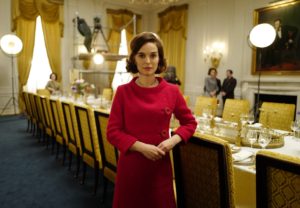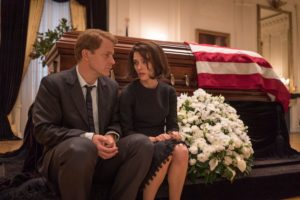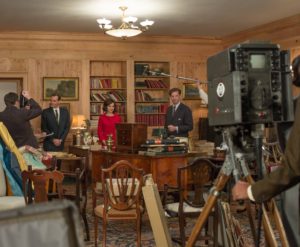
Set during the days immediately following her husband’s assassination, Jackie recounts one of the most tragic events in American history as seen through the eyes of the iconic First Lady, Jacqueline Bouvier Kennedy (Natalie Portman).
Director Pablo Larraín has an affinity for historical characters of mythic proportions. Of the seven films that he has directed, five are period pieces, although that was never his plan. He embraces stories based on history because he feels those stories give context to the human experience and who we are. Noah Oppenheim’s script portrayed Jackie over a compressed time period, during her greatest personal crisis. Because behavior in a crisis is generally not normal behavior, the heartrending events manifested within Jackie as deep strength and determination.
“You need the splendor and the crisis to create circumstances that are out of control,” stated Larraín. “When there is that lack of control, you get to see someone in a very particular way.”
Larraín read “a ton” of biographies, talked to a lot of people, did research, read articles, saw movies, but he felt nobody really knew who Jackie was. Watching the tour that Jackie filmed while she occupied the White House, Larraín discovered that the first lady was really a mysterious person. Interviews gave insight into who she was, but Larraín thought he didn’t really know what was going on inside of those eyes.
“I think it is interesting and beautiful to go back, and through cinema, try to think what they thought, feel what they felt, and be what they were,” shared Larraín. “At some point it means a lot because you can try to understand what we are, through the process of examining the past.”
The intimate nature of Larraín’s filmmaking style can be partially attributed to his tight connection with cinematographer, Stephane Fontaine. To get a feel for the period the filmmakers interspersed contemporary 16 mm cinematography with historical black and white newsreel footage. Once they understood how they wanted to shoot the film, something magical happened. Although they had shots using Steadicams, cranes and tracks, most of the footage was handheld. When Fontaine put the camera on his shoulder it exactly matched Portman’s height.
“They were like dancing,” noted Larraín. “He is such a beautiful artist with all his textures and how he looked at her. This movie would have been very different if somebody else had shot it. You never know, because you make a movie just once, but I think Stephan’s work was essential.”
Not a director that sits on a chair, far from set, watching the monitor and giving instructions over a radio, Larraín stays next to the camera, as close as possible to the actors, because there is a chemistry that happens on set that is ultimately captured on film.

“Of course, films are made with scripts. You need the structure and the plot, but there is something that you try to achieve that is not there – the tone, the rhythm and the atmosphere of a movie that is essential to the experience,” said Larraín. “That is how you decide to express yourself through the tools of cinematography: the cameras, the lenses, the framing. That’s what creates what you are going to see. How you use the camera, it’s your calligraphy. It’s unique. Nobody writes like you. That’s why I am so connected with the camera work.”
The Camelot myth that the president and first lady were identified with, came from the popular musical of the same name that JFK often listened to. Larraín, who was not familiar with the musical when he took on the project, specifically requested a vinyl copy of the record.
“Somebody found it. They gave me this record player, and I went home in Paris and I played it. I could not believe what I was listening to,” revealed Larraín. “So particular. So beautiful. I decided to bring it into the script.”
The screenwriter agreed. Setting the scene with the Camelot record playing on a 60’s turntable, the musical’s title song became the soundtrack for an emotionally layered montage – a visual metaphor of Jackie’s mental state, with the first lady alone in the family quarters of the White House, late at night, drinking, compulsively trying on dresses – in some ways dressing for her dead husband – trying to figure out who she is, while suffering a “crisis of identity.”
“Did Jackie Kennedy do that? I don’t think so,” stated Larraín. “I don’t know. There is no record. We thought it was beautiful and interesting. The facts are very accurate in the film, but once you are behind doors, nobody knows exactly what happened or what was being said. We tried to imagine and capture a specific sensibility and emotion, and share it with the audience.”
The whole film hinged upon the performance by Portman. When Larraín was invited to direct the film by producer Darren Aronofsky, the director had one condition. He would only do the film with Portman in the role of Jackie. Aronofsky smiled and agreed to set-up a meeting between the director and the actress.
“Then I met Natalie and told her, ‘I will only make this movie if you do it. If you don’t do it, I’m just not going to do it,’” explained Larraín. “I’m sure there are many actresses that could be great in the role, but not for my eyes.”
The crew collaborations were “like a flow.” Larraín felt his production designer, Jean Rabasse, had an incredible way of portraying the world of the Kennedy era, with its textures and colors, when he reconstructed the White House on a Paris stage. Madeline Fontaine had to refabricate the wardrobe of one of America’s style icons, including the famous pink outfit and pillbox hat, seared into our collective memories of that fateful day. In editing, the director felt that Sebastián Sepúlveda was rewriting the film.

“It’s a family of people that put their desires on screen.” Larraín, who directed one opera, elaborated with a metaphor, “Opera is so close to cinema. There is a conductor, which is me, and there are singers, which are the actors, but they need an orchestra and they need everything else, which is the crew.”
The filmmaking process relied heavily upon teamwork. 80% of the film was shot in Paris with a French crew. Producers were from the United States and Chile, including the director’s brother, Juan de Dios Larraín. All the actors were American. Post-production was primarily in Chile. And although the film was about an American icon, the international crew related to the story as human beings and became emotionally connected to the character and what she was going through.
Larraín concluded, “We fell in love with Jackie and who she was. We all wanted to protect her.”





